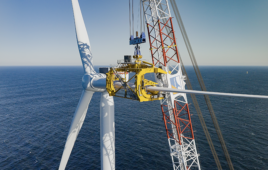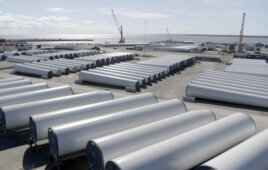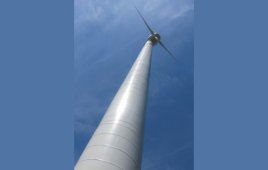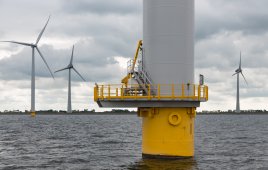A couple aspiring engineers have examined the water needs of rice farmers in India, Kenya, and Philippines, and devised a system that uses a small-wind turbine, an electric pump, batteries, and controls to provide about 110,000 liter/day for a seven-acre paddy. But the real genius of the concept is to mount the turbine on a Palmyra palm tree, about 10m up. The clamp would let the turbine rotate, presumably down wind. Team Anemoi, Ms. Rini Bharadwaj and Vivian Manohar, presented their concept and research in France for a contest called Go green in the city, sponsored by Schneider Electric. Good news: they won!

An Asian or African Palmyra palm (borassus flabellifer) has an average height of 20m, and is highly drought and cyclone resistant.
Regarding the suitability of palm trees as towers: Small wind turbines are typically installed on towers so they are at least 10m above obstacles within 300 ft. An Asian or African Palmyra palm (borassus flabellifer) has an average height of 20m, and is highly drought and cyclone resistant. Unlike other woody trees, if the turbine fixture damages the outer surface of the trunk, the tree is not affected.
The scarcity of power and water
Team Anemoi’s contest entry points out irony of the modern world: while we praise the esoteric detection of gravitational waves, 1.3 billion people still lack access to electricity. Many rural communities, which depend on climate-sensitive activities such as agriculture, still suffer from water scarcity. Team Anemoi believes that grass root-level developments hold the key to addressing such global challenges.
Their objective is to develop an off-grid wind and pump system that provides rural agricultural communities with access to clean, low-cost energy. “Our primary focus is on the farmers living in the developing countries of Asia and South-East Asia where the Asian Palmyra palm trees, our proposed towers, are abundant,” says Bharadwaj.
She says that even if the rural villages get connected to the main grid, the paddy fields and the agriculture pumps are usually several kilometers away from villages and the grid.
Solar-powered water pumps are typically proposed for off-grid irrigation. But farmers who make less than $3/day have difficulty considering solar panels for $2,000. The next feasible option is to consider small-wind turbines. “Though they are cheaper than solar, we found that the total installation cost of a steel tower is twice as much as the cost of the turbine. What’s more, the farmers often over-pump, thereby using more water and electricity than required,” she said.
Team Anemoi’s approach, which mounts the turbine on a palm tree, provides these advantages:
- 25% cheaper than the conventional small-wind turbine and pump systems
- 44% cheaper than solar panels and pump systems
- 60% less initial investment cost than connecting to the grid
- 42,000 kg of CO2 could be saved during the lifetime of a single system
- Visually appealing and quieter than conventional wind turbines
“We have designed the wind turbine and pump system so that it can satisfy the norms (1) specified by the Indian government for solar pumps, which states that a one-hp solar powered pump must be able to deliver 90,000l/day from a head of 10m using a 900W solar panel. We calculate that this specification can be achieved at a much lower cost by combining a 2-kW wind turbine, a 1-hp pump, and a 10-kWh battery pack,” she says.
The following ideas make the system more cost-effective:
- Eliminating the cost and carbon footprint of steel towers by replacing them with palm trees
- Reducing the power demand by optimizing irrigation needs using water-level sensors
- Using the Internet of Things (IoT) for controlling and monitoring the system
“To begin with, we have chosen India, Kenya, and Philippines. Because the agriculture sector plays a significant role in these economies, the irrigation pumps require regular supply of electricity. Fortunately, both countries possess a huge small-wind power potential,” said Bharadwaj. Recent studies (3) show that in India, 50% of 420 districts have a wind speed of more than 5 m/s, where the Mean Annual Wind Speed was measured at 20m.
Philippines has a small-wind power potential of 173.6 GW in areas covering about 8% of the total land area. Both countries possess wind potential and Asian Palmyra palms, and could benefit from renewable energy to fuel their fast growing economies. Hence, there is a sizeable market for this project.
Team Anemoi would like to acknowledge the inspiration provided by Schneider Electric’s BipBop and Access to Energy programs.
Caption for the table Initial investment cost
This is much cheaper than connecting pumps to the grid. The capital cost of a grid extension to a pump is about $8,000/km. (2)
For further reading:
- Ministry of New and Renewable Energy, Jawaharlal Nehru National Solar Mission, Solar photovoltaic water pumping systems
Technical-specification_spwps_2013_14.pdf - PV solutions for an economic energy supply, ARE_Publication_-_Case_studies_for_renewables_in_Developing_countries.pdf
- List of wind monitoring stations with 20m MAWS (MNRE as on 31.05.2016) for establishing of small wind turbine, http://niwe.res.in/assets/Docu/List_of_WMS_20m_May_2016.pdf
Filed Under: Towers





